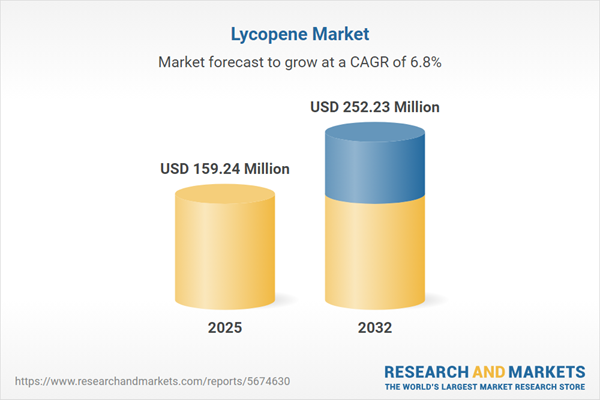Speak directly to the analyst to clarify any post sales queries you may have.
The lycopene market is evolving as clean-label trends and modern extraction processes transform sourcing and enable B2B buyers to capture new applications across industries. Decision-makers have an opportunity to recalibrate strategies and investment in line with shifting industry needs.
Lycopene Market Snapshot: Growth and Outlook
The global lycopene market is projected to increase in value from USD 149.30 million in 2024 to USD 159.24 million by 2025, reaching USD 252.23 million by 2032. This growth corresponds to a compound annual growth rate (CAGR) of 6.77%. Momentum is driven by heightened demand for functional ingredients, evolving wellness objectives, and rising consumer expectations. Leading providers are advancing extraction techniques and delivery systems, addressing the sector’s push for product and process innovation. These approaches foster compliance, broaden product uses, and enhance regional reach, reflecting larger trends in the functional ingredient industry.
Lycopene Market Scope & Segmentation
- Applications: Supports cosmetics and personal care by offering natural color and robust antioxidant content, giving manufacturers a clean-label solution and catering to modern preferences in skincare and haircare.
- Dietary Supplements: Delivered via capsules, gummies, or tablets, allowing businesses to address personalized nutrition and adapt procurement to new supplement consumption patterns.
- Food and Beverage: Adds functional value to bakery, dairy, beverage, and confectionery products, facilitating nutritional differentiation and a more targeted product portfolio to meet segment-specific needs.
- Form Types: Includes beadlets for greater ingredient stability, oil suspensions utilizing MCT or soybean carriers for improved formulation, and powdered forms made through freeze or spray drying to optimize manufacturing adaptability.
- Sources: Derived from tomatoes and fruit extracts bolsters natural and sustainable product narratives, while synthetic lycopene ensures formulation precision meeting exacting customer requirements.
- Distribution Channels: Leveraged through online marketplaces for widespread reach, pharmacies for clinical positioning, and supermarkets or hypermarkets for broad market accessibility and agile supply.
- Geographic Regions: Market presence established across Americas, Europe, Middle East and Africa, and Asia-Pacific, with region-specific product positioning, compliance, and tailored entry approaches to address local regulatory and customer demands.
- Featured Companies: Key participants such as BASF SE, Koninklijke DSM N.V., Givaudan International S.A., Symrise AG, Kemin Industries, Indena S.p.A., Carotech Berhad, and Allied Biotech Corporation offer secure supply chains, deep formulation expertise, and high adaptability in response to evolving customer needs.
Key Takeaways for Market Leaders
- Lycopene functions both as a natural colorant and a bioactive compound, enabling supply chain traceability and meeting transparency benchmarks valued by B2B buyers focused on responsible sourcing.
- Innovations in extraction and encapsulation multiply formulation options, supporting rapid new product development within supplements and functional foods.
- Increasing regulatory scrutiny requires robust compliance systems and drives a trend toward clinical validation for improved trust among stakeholders.
- Progress in supply chain transparency and pursuit of recognized sustainability certifications foster collaboration and simplify integration with large-scale buyer networks.
- Innovation partnerships and collaborative models are key, enabling faster adaptation to wellness trends and regulatory changes by co-developing tailored solutions.
- Strategic sourcing diversification and customized regional approaches help maintain resilience against market disruptions and better serve key territories.
Tariff Impact and Supply Chain Realignment
Shifting tariffs influence lycopene production by encouraging increased regional sourcing and nearshoring efforts to reduce logistics exposure. Building robust supplier networks, especially in geopolitically sensitive markets, secures the value chain and decreases reliance on long-haul transport. Investments in beadlet and advanced oil suspension formats further reinforce product stability in the face of evolving transport, regulatory, and compliance pressures.
Methodology & Data Sources
This research utilizes a combination of primary and secondary qualitative methodologies, including direct stakeholder interviews and analysis of formulation, compliance, and procurement practices. The approach delivers market intelligence that accurately reflects the present lycopene industry landscape for B2B procurement.
Why This Report Matters: Decision-Ready Insights
- Obtain insights enabling improved procurement, enhanced compliance, and sophisticated risk assessment—directly supporting business strategy.
- Use frameworks to proactively address regulatory change, boost supply chain resilience, and increase operational productivity on an international scale.
- Leverage competitive benchmarking and certification guidance to support procurement and strategic market planning.
Conclusion
Lycopene market expansion is closely linked with technology advancements, regulatory demands, and sustainability goals. Organizations prioritizing supply chain agility and advanced compliance are positioned to realize emerging market opportunities and support evolving client requirements.
Additional Product Information:
- Purchase of this report includes 1 year online access with quarterly updates.
- This report can be updated on request. Please contact our Customer Experience team using the Ask a Question widget on our website.
Table of Contents
3. Executive Summary
4. Market Overview
7. Cumulative Impact of Artificial Intelligence 2025
Companies Mentioned
The companies profiled in this Lycopene market report include:- BASF SE
- Koninklijke DSM N.V.
- Givaudan International S.A.
- Symrise AG
- Kemin Industries, Inc.
- Indena S.p.A.
- Carotech Berhad
- Allied Biotech Corporation
Table Information
| Report Attribute | Details |
|---|---|
| No. of Pages | 195 |
| Published | November 2025 |
| Forecast Period | 2025 - 2032 |
| Estimated Market Value ( USD | $ 159.24 Million |
| Forecasted Market Value ( USD | $ 252.23 Million |
| Compound Annual Growth Rate | 6.7% |
| Regions Covered | Global |
| No. of Companies Mentioned | 9 |









